Discussion
Home ‣ Electronics and Communication Engineering ‣ Matching Questions See What Others Are Saying!
- Question
Match the following:
List I (Microwave device) List II (Application) A. PIN diode 1. Microwave amplification B. GaAs MOSFET 2. Low noise microwave generation C. Transferred electron device 3. Electronic tuning of MW oscillator D. Varactor diode 4. Light wave detection
Options- A. A-1, B-2, C-4, D-3
- B. A-4, B-1, C-2, D-3
- C. A-2, B-3, C-1, D-4
- D. A-3, B-4, C-2, D-1
- Correct Answer
- A-4, B-1, C-2, D-3
- 1. In the circuit below, delay of the EXOR and AND
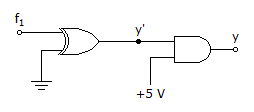
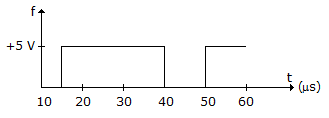
Logic gates are 20 ?s and 10 ?s respectively, then the wave y' and y (with initial condition y = 1) will be :
Options- A.
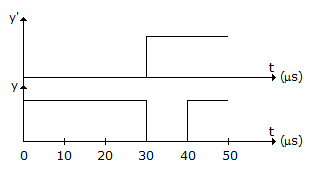
- B.
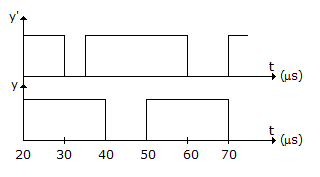
- C.
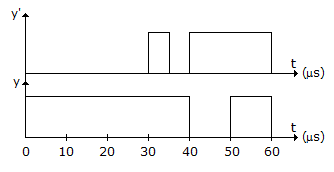
- D.
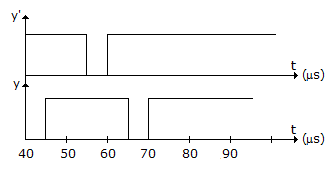 Discuss
Discuss
- 2. In microwave circuits, a mode transducer is used to
Options- A. change mode of wave transmission
- B. change direction of wave transmission
- C. change polarization of wave transmission
- D. change mode, direction or polarization wave transmission Discuss
- 3. In a microstrip transmission the signal can be easily redirected by changing the centre strip.
Options- A. True
- B. False Discuss
- 4. When Schrodinger equation is applied to the motion of electron in the field of protons, the physically acceptable solutions for the wave function exist for quantum number which are
Options- A. 2
- B. 3
- C. 4
- D. 5 Discuss
- 5. Macroscopic quantities of a given material
Options- A. are absolutely constant
- B. are a function of temperature
- C. are a function of temperature, pressure field
- D. none of the above Discuss
- 6. An homogeneous dielectric material is subjected to an electric field E. If a small cavity is made inside the material, the electric field intensity inside and outside the cavity are different.
Options- A. True
- B. False Discuss
- 7. In an hydrogen atom, an electron moves in the field of a proton. The stability of orbit requires equilibrium between coulomb's force and centrifugal force.
Options- A. True
- B. False Discuss
- 8. The core of an atom consists of
Options- A. nucleus
- B. nucleus and all orbits
- C. nucleus and inner orbits
- D. none of the above Discuss
- 9. For dielectrics in alternating field, polarizability ae is a complex quantity. The imaginary part of ae is zero for
Options- A. ? = 0
- B. ? ? ?
- C. ? = 0 and ? ? ?
- D. ? = natural frequency ?0 Discuss
- 10. The wavelength of light emitted by GaAs laser is 8670 x 10-10 m. If h = 6.626 x 10-34 Js, velocity of light = 3 x 108 m/s and eV = 1.602 x 10-19 J, the energy gap in GaAs is
Options- A. 0.18 eV
- B. 0.7 eV
- C. 1.43 eV
- D. 2.39 eV Discuss
More questions
Correct Answer:

Explanation:
Since y is at logic '1' initially, y' must be at logic '1'.
Also, one input of the EXOR gate is tied to zero therefore 'f' will be directly transferred to the output.
The logic gates will introduce gate delays which will lead to the answer .
Correct Answer: change mode, direction or polarization wave transmission
Correct Answer: True
Explanation:
A Microstrip line has a single dielectric substratc with ground plane on one side and a strip on the other face.
Its special feature is easy access to top surface so that minor adjustments can be made after circuit fabrication.
The high dielectric constant of the substrate reduces guide wavelength and circuit dimensions.
A microstrip line is the most commomly used transmission structure for microwave integrated circuits.
Correct Answer: 3
Explanation:
There are three principal quantum numbers.
Correct Answer: none of the above
Correct Answer: False
Explanation:
The electric field intensity inside and outside the cavity are equal.
Correct Answer: True
Explanation:
Orbit is stable only if the two forces are equal and opposite.
Correct Answer: nucleus and inner orbits
Correct Answer: ? = 0 and ? ? ?
Explanation:
Imaginary part of ae is zero for ? = 0 and ? = ?.
Correct Answer: 1.43 eV
Comments
There are no comments.More in Electronics and Communication Engineering:
Programming
Copyright ©CuriousTab. All rights reserved.
